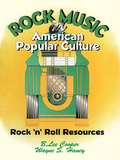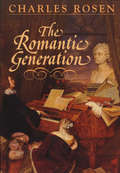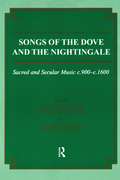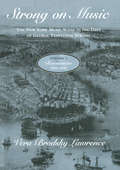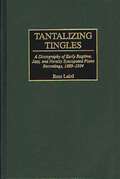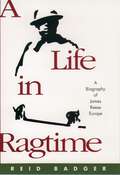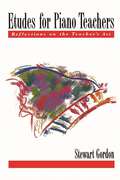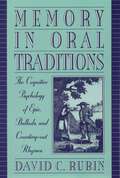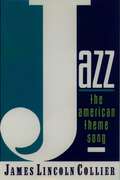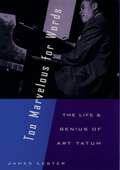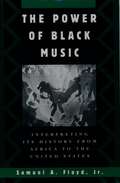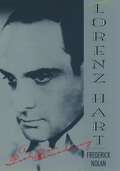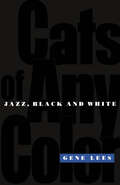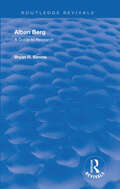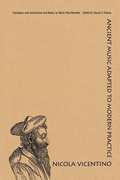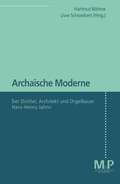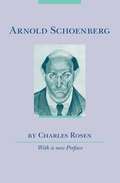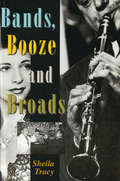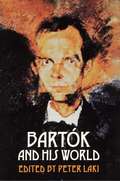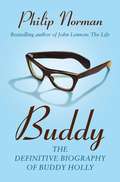- Table View
- List View
Rock Music in American Popular Culture: Rock 'n' Roll Resources
by Frank Hoffmann B Lee Cooper Wayne S HaneyHow does rock music impact culture? According to authors B. Lee Cooper and Wayne S. Haney, it is central to the definition of society and has had a great impact on shaping American culture. In Rock Music in American Popular Culture, insightful essays and book reviews explore ways popular culture items can be used to explore American values. This fascinating book is arranged alphabetically for quick and easy reference to specific topics, but the book is equally enjoyable to read straight through.The influence of rock era music is evident throughout the text, demonstrating how various topics in the popular culture field are interconnected. Students in popular culture survey courses and American studies classes will be fascinated by these unique explorations of how family businesses, games, nursery rhymes, rock and roll legends, and other musical ventures shed light on our society and how they have shaped American values over the years.
The Romantic Generation (The\charles Eliot Norton Lectures #2018)
by Charles RosenWhat Charles Rosen’s celebrated book The Classical Style did for music of the Classical period, The Romantic Generation brilliantly does for the Romantic era. An exhilarating exploration of the musical language, forms, and styles of the Romantic period, it captures the spirit that enlivened a generation of composers and musicians, and in doing so it conveys the very sense of Romantic music. In readings uniquely informed by his performing experience, Rosen offers consistently acute and thoroughly engaging analyses of works by Schubert, Schumann, Mendelssohn, Bellini, Liszt, and Berlioz, and he presents a new view of Chopin as a master of polyphony and large-scale form. He adeptly integrates his observations on the music with reflections on the art, literature, drama, and philosophy of the time, and thus shows us the major figures of Romantic music within their intellectual and cultural context. Rosen covers a remarkably broad range of music history and considers the importance to nineteenth-century music of other cultural developments: the art of landscape, a changed approach to the sacred, the literary fragment as a Romantic art form. He sheds new light on the musical sensibilities of each composer, studies the important genres from nocturnes and songs to symphonies and operas, explains musical principles such as the relation between a musical idea and its realization in sound and the interplay between music and text, and traces the origins of musical ideas prevalent in the Romantic period. Rich with striking descriptions and telling analogies, Rosen’s overview of Romantic music is an accomplishment without parallel in the literature, a consummate performance by a master pianist and music historian.
The Social and Religious Designs of J. S. Bach's Brandenburg Concertos
by Michael MarissenThis new investigation of the Brandenburg Concertos explores musical, social, and religious implications of Bach's treatment of eighteenth-century musical hierarchies. By reference to contemporary music theory, to alternate notions of the meaning of "concerto," and to various eighteenth-century conventions of form and instrumentation, the book argues that the Brandenburg Concertos are better understood not as an arbitrary collection of unrelated examples of "pure" instrumental music, but rather as a carefully compiled and meaningfully organized set. It shows how Bach's concertos challenge (as opposed to reflect) existing musical and social hierarchies. Careful consideration of Lutheran theology and Bach's documented understanding of it reveals, however, that his music should not be understood to call for progressive political action. One important message of Lutheranism, and, in this interpretation, of Bach's concertos, is that in the next world, the heavenly one, the hierarchies of the present world will no longer be necessary. Bach's music more likely instructs its listeners how to think about and spiritually cope with contemporary hierarchies than how to act upon them. In this sense, contrary to currently accepted views, Bach's concertos share with his extensive output of vocal music for the Lutheran liturgy an essentially religious character.
Songs of the Dove and the Nightingale: Sacred and Secular Music c.900-c.1600 (Musicology)
by Greta Mary Hair Robyn E. SmithFirst Published in 1995. Routledge is an imprint of Taylor & Francis, an informa company.
Songs of the Dove and the Nightingale: Sacred and Secular Music c.900-c.1600 (Musicology #17)
by Greta Mary Hair Robyn E. SmithFirst Published in 1995. Routledge is an imprint of Taylor & Francis, an informa company.
Strong on Music: The New York Music Scene in the Days of George Templeton Strong, Volume 1: Resonances, 1836-1849
by Vera Brodsky LawrenceIn Strong on Music Vera Brodsky Lawrence uses the diaries of lawyer and music lover George Templeton Strong as a jumping-off point from which to explore every aspect of New York City's musical life in the mid-nineteenth century. Formerly a concert pianist, Vera Brodsky Lawrence spent the last third of her life as a historian of American music (she died in 1996). She was editor of The Piano Works of Louis Moreau Gottschalk and The Complete Works of Scott Joplin. On Volume 1: "A marvelous book. There is nothing like it in the literature of American music."—Harold C. Schonberg, New York Times Book Review On Volume 2: "A monumental achievement."—Victor Fell Yellin, Opera Quarterly
Tantalizing Tingles: A Discography of Early Ragtime, Jazz, and Novelty Syncopated Piano Recordings, 1889-1934 (Discographies: Association for Recorded Sound Collections Discographic Reference)
by Ross LairdFor the first time, all data for recordings of non-classical piano made for issue on disc and cylinder records prior to 1935 are brought together in this work. The majority of the listing consists of material which has never been published in any form. The volume includes piano solos, duets, trios, and quartets, as well as selected titles where a soloist is featured within a recording by a dance band or orchestra. It covers a wide variety of pianists and piano styles including ragtime, stride, novelty-syncopated, boogie, and blues. This work will be of interest to major libraries, archives, and schools of music, as well as researchers and collectors.The recordings covered in this work range from the earliest known piano recordings which were made in 1889 as cylinder records for the North American Phonograph Company through recordings of the early 1930s by some of the great jazz pianists of that era (Mary Lou Williams, Garland Wilson, Herman Chittison, Art Tatum, and Teddy Wilson). In between are a wide variety of pianists and piano styles from around the world. While many of the solos recorded were of popular tunes of the day, there is also a fascinating selection of piano compositions, often played by the composer. They include such well-known names as Felix Arndt, Nacio Herb Brown, Hoagy Carmichael, Rudolf Friml, George Gershwin, John W. Green, Ferdie Grofe, Ralph Rainger, Leslie Stuart, Clarence Williams, and Vincent Youmans. A comprehensive title index includes composer credits for the majority of titles listed.
A Life in Ragtime: A Biography of James Reese Europe
by Reid BadgerIn 1919, the world stood at the threshold of the Jazz Age. The man who had ushered it there, however, lay murdered--and would soon plunge from international fame to historical obscurity. It was a fate few would have predicted for James Reese Europe; he was then at the pinnacle of his career as a composer, conductor, and organizer in the black community, with the promise of even greater heights to come. "People don't realize yet today what we lost when we lost Jim Europe," said pianist Eubie Blake. "He was the savior of Negro musiciansin a class with Booker T. Washington and Martin Luther King." In A Life in Ragtime , Reid Badger brilliantly captures this fascinating life, tracing a critical chapter in the emergence of jazz through one man's remarkable odyssey. After an early start in Washington, Europe found his fame in New York, the entertainment capital of turn-of-the-century America. In the decade before the First World War, he emerged as an acknowledged leader in African-American musical theater, both as a conductor and an astonishingly prolific composer. Badger reveals a man of tremendous depths and ambitions, constantly aspiring to win recognition for black musicians and wider acceptance for their music. He toiled constantly, working on benefit concerts, joining hands with W.E.B. Du Bois, and helping to found a black music school--all the while winning commercial and critical success with his chosen art. In 1910, he helped create the Clef Club, making it the premiere African-American musical organization in the country during his presidency. Every year from 1912 to 1914, Europe led the Clef Club orchestra in triumphant concerts at Carnegie Hall, winning new respectability and popularity for ragtime. He went on to a tremendously successful collaboration with Vernon and Irene Castle, the international stars who made social dancing a world-wide rage. Along the way, Europe helped to revolutionize American music--and Badger provides fascinating details of his innovations and wide influence. In World War I, the musical pioneer won new fame as the first African-American officer to lead men into combat in that conflict--but he was best known as band leader for the all-black 15th Infantry Regiment. As the "Hellfighters" of the 15th racked up successes on the battlefield, Europe's band took France by storm with the new sounds of jazz. In 1919, the soldiers returned to New York in triumph, and Europe was the toast of the city. Then, just a few months later, he was dead--stabbed to death by a drummer in his own orchestra. From humble beginnings to tragic end, the story of Jim Europe comes alive in Reid Badger's account. Weaving in the wider story of our changing culture, music, and racial conflict, Badger deftly captures the turbulent, promising age of ragtime, and the drama of a triumphant life cut short.
Etudes for Piano Teachers: Reflections on the Teacher's Art
by Stewart GordonJust as musical etudes focus on the development of skills and address the technical problems encountered in keyboard literature, the "etudes" in Stewart Gordon's new book also focus on ideas which prepare piano teachers for meeting the problems encountered in piano performing and teaching. This major new collection on the piano teacher's art opens with an assessment of the role of the piano teacher, and goes on to explore various types of students and the challenge each presents: the moderately talented, but ambitious, student; the late beginner; the unusually gifted. Drawing on thirty years of teaching and performing, Gordon then bring fresh ideas to bear on the often-discussed areas of inner-hearing, pulse regulation, improvisation, sight-reading, and collaborative music making. There are sections on performance procedures, memorizing, pedalling, and historical performance practices; a carefully-balanced consideration of the role of the piano student and teacher; and realistic looks at the problems facing the profession today, the dynamics of a performing career, and the stages through which musicians' careers often pass. Designed to open up new avenues of inquiry, to provoke discussion and creative thinking, and to challenge and motivate students, these essays will be vital reading for all serious piano students and teachers.
Memory in Oral Traditions: The Cognitive Psychology of Epic, Ballads, and Counting-out Rhymes
by David C. RubinLong studied by anthropologists, historians, and linguists, oral traditions have provided a wealth of fascinating insights into unique cultural customs that span the history of humankind. In this groundbreaking work, cognitive psychologist David C. Rubin offers for the first time an accessible, comprehensive examination of what such traditions can tell us about the complex inner workings of human memory. Focusing in particular on their three major forms of organization--theme, imagery, and sound pattern--Rubin proposes a model of recall, and uses it to uncover the mechanisms of memory that underlie genres such as counting-out rhymes, ballads, and epics. The book concludes with an engaging discussion of how conversions from oral to written communication modes can predict how cutting-edge computer technologies will affect the conventions of future transmissions. Throughout, Rubin presents the results of important original research as well as new perspectives on classical subjects. Splendidly written and farsighted, Memory in Oral Traditions will be eagerly read by students and researchers in areas as diverse as cognitive psychology, literary studies, classics, and cultural anthropology.
Jazz: The American Theme Song
by James Lincoln CollierPraised by the Washington Post as a "tough, unblinkered critic," James Lincoln Collier is probably the most controversial writer on jazz today. His acclaimed biographies of Louis Armstrong, Duke Ellington, and Benny Goodman continue to spark debate in jazz circles, and his iconoclastic articles on jazz over the past 30 years have attracted even more attention. With the publication of Jazz: The American Theme Song, Collier does nothing to soften his reputation for hard-hitting, incisive commentary. Questioning everything we think we know about jazz--its origins, its innovative geniuses, the importance of improvisation and spontaneous inspiration in a performance--and the jazz world, these ten provocative essays on the music and its place in American culture overturn tired assumptions and will alternately enrage, enlighten, and entertain. Jazz: The American Theme Song offers music lovers razor-sharp analysis of musical trends and styles, and fearless explorations of the most potentially explosive issues in jazz today. In "Black, White, and Blue," Collier traces African and European influences on the evolution of jazz in a free-ranging discussion that takes him from the French colony of Saint Domingue (now Haiti) to the orderly classrooms where most music students study jazz today. He argues that although jazz was originally devised by blacks from black folk music, jazz has long been a part of the cultural heritage of musicians and audiences of all races and classes, and is not black music per se. In another essay, Collier provides a penetrating analysis of the evolution of jazz criticism, and casts a skeptical eye on the credibility of the emerging "jazz canon" of critical writing and popular history. "The problem is that even the best jazz scholars keep reverting to the fan mentality, suddenly bursting out of the confines of rigorous analysis into sentimental encomiums in which Hot Lips Smithers is presented as some combination of Santa Claus and the Virgin Mary," he maintains. "It is a simple truth that there are thousands of high school music students around the country who know more music theory than our leading jazz critics." Other, less inflammatory but no less intriguing, essays include explorations of jazz as an intrinsic and fundamental source of inspiration for American dance music, rock, and pop; the influence of show business on jazz, and vice versa; and the link between the rise of the jazz soloist and the new emphasis on individuality in the 1920s. Impeccably researched and informed by Collier's wide-ranging intellect, Jazz: The American Theme Song is an important look at jazz's past, its present, and its uncertain future. It is a book everyone who cares about the music will want to read.
Too Marvelous for Words: The Life and Genius of Art Tatum
by James LesterArt Tatum defined the limits of the possible in jazz piano. Gunther Schuller called Tatum's playing "a marvel of perfection.... His deep-in-the-keys full piano sonority, the tone and touch control in pyrotechnical passages...are miracles of performance." Whitney Balliett wrote "no pianist has ever hit notes more beautifully. Each one--no matter how fast the tempo--was light and complete and resonant, like the letters on a finely printed page." His famous runs have been compared to the arc left against the night sky by a Fourth-of-July sparkler. And to have heard him play, one musician said, "was as awe-inspiring as to have seen the Grand Canyon or Halley's Comet." Now, in Too Marvelous For Words, James Lester provides the first full-length biography of the greatest virtuoso performer in the history of jazz. Before this volume, little was known about Tatum, even among jazz afficionados. What were his origins, who taught him and who provided early pianistic influences, how did he break into the jazz field, what role did he play in the development of other jazz players, and what was he like when he wasn't playing? To answer these questions, Lester has conducted almost a hundred interviews for this book, with surviving family, childhood friends, schoolteachers, and the famous jazz musicians who played with him or knew him. Lester creates a memorable portrait of this unique musician and of the vibrant jazz world of the 1930s and 1940s, capturing the complexity and vitality of this remarkable performer. Tatum, who was virtually blind, suffering between 70% and 90% visual impairment, emerges as cheerful, fun-loving, energetic and out-going, with none of the demonic self-destructiveness that seemed to haunt such jazz greats as Charlie Parker or Billie Holiday. He often joked about his blindness, but did not like it mentioned as a handicap and preferred to pre-plan his entrance to the piano in a club, rather than have someone lead him there. He was simply inexhaustible and had a life-long habit of staying up all night after a gig, usually seeking an after-hours club in which to listen and play until daybreak. Lester also reveals that Tatum was generous with younger players, but his extraordinary technical brilliance often devastated them. No less a talent than Oscar Peterson remembers that after first hearing Tatum, "I gave up the piano for two solid months, and I had crying fits at night." And Les Paul remarked that after hearing Tatum for the first time, he quit piano completely and began playing guitar. Perhaps most important, Lester provides a thorough, knowledgeable discussion of Tatum's music, from his early influences, such as stride pianist Fats Waller, to his mature style in which Liszt, Rachmaninoff, Debussy, Waller, and Earl Hines all became grist for his harmonic mill. From unexceptional origins in Toledo, Ohio, Art Tatum evolved into a world-class musician whose importance in jazz is comparable to Louis Armstrong and Charlie Parker and whose command of the piano captured the admiration of Horowitz and Paderewski. Too Marvelous For Words is the first full portrait of this extraordinary musical genius.
The Power of Black Music: Interpreting Its History from Africa to the United States
by Samuel A. FloydWhen Jimi Hendrix transfixed the crowds of Woodstock with his gripping version of "The Star Spangled Banner," he was building on a foundation reaching back, in part, to the revolutionary guitar playing of Howlin' Wolf and the other great Chicago bluesmen, and to the Delta blues tradition before him. But in its unforgettable introduction, followed by his unaccompanied "talking" guitar passage and inserted calls and responses at key points in the musical narrative, Hendrix's performance of the national anthem also hearkened back to a tradition even older than the blues, a tradition rooted in the rings of dance, drum, and song shared by peoples across Africa. Bold and original, The Power of Black Music offers a new way of listening to the music of black America, and appreciating its profound contribution to all American music. Striving to break down the barriers that remain between high art and low art, it brilliantly illuminates the centuries-old linkage between the music, myths and rituals of Africa and the continuing evolution and enduring vitality of African-American music. Inspired by the pioneering work of Sterling Stuckey and Henry Louis Gates, Jr., author Samuel A. Floyd, Jr, advocates a new critical approach grounded in the forms and traditions of the music itself. He accompanies readers on a fascinating journey from the African ring, through the ring shout's powerful merging of music and dance in the slave culture, to the funeral parade practices of the early new Orleans jazzmen, the bluesmen in the twenties, the beboppers in the forties, and the free jazz, rock, Motown, and concert hall composers of the sixties and beyond. Floyd dismisses the assumption that Africans brought to the United States as slaves took the music of whites in the New World and transformed it through their own performance practices. Instead, he recognizes European influences, while demonstrating how much black music has continued to share with its African counterparts. Floyd maintains that while African Americans may not have direct knowledge of African traditions and myths, they can intuitively recognize links to an authentic African cultural memory. For example, in speaking of his grandfather Omar, who died a slave as a young man, the jazz clarinetist Sidney Bechet said, "Inside him he'd got the memory of all the wrong that's been done to my people. That's what the memory is....When a blues is good, that kind of memory just grows up inside it." Grounding his scholarship and meticulous research in his childhood memories of black folk culture and his own experiences as a musician and listener, Floyd maintains that the memory of Omar and all those who came before and after him remains a driving force in the black music of America, a force with the power to enrich cultures the world over.
Lorenz Hart: A Poet on Broadway
by Frederick NolanLorenz Hart singlehandedly changed the craft of lyric writing. When Larry Hart first met Dick Rodgers in 1919, the commercial song lyric consisted of tired cliches and cloying Victorian sentimentality. Hart changed all that, always avoiding the obvious, aiming for the unexpected phrase that would twang the nerve or touch the heart. Endowed with both a buoyant wit and a tender, almost raw sincerity, Hart brought a poetic complexity to his art, capturing the everyday way people talk and weaving it into his lyrics. Songs had never been written like that before, and afterwards it seemed impossible that songs would ever be written any other way. Lorenz Hart: A Poet on Broadway presents the public triumphs of a true genius of the American musical theatre, and the personal tragedies of a man his friend the singer Mabel Mercer described as "the saddest man I ever knew." Author Frederick Nolan began researching this definitive biography in 1968, tracking down and interviewing Hart's friends and collaborators one by one, including a remarkable conversation with Richard Rodgers himself. A veritable who's who of Broadway's golden age, including Joshua Logan, Gene Kelly, George Abbott and many more, recall their uncensored and often hilarious, sometimes poignant memories of the cigar-chomping wordsmith who composed some of the best lyrics ever concocted for the Broadway stage, but who remained forever lost and lonely in the crowds of hangers-on he attracted. A portrait of Hart emerges as a Renaissance and endearing bon vivant conflicted by his homosexuality and ultimately torn apart by alcoholism. Nolan skillfully pulls together the chaotic details of Hart's remarkable life, beginning with his bohemian upbringing in turn of the century Harlem. Here are his first ventures into show business, and the 24-year-old Hart's first meeting with the 16-year-old Richard Rodgers. "Neither of us mentioned it," Rodgers later recalled, "but we evidently knew we would work together, and I left Hart's house having acquired in one afternoon a career, a best friend, and a source of permanent irritation." Nolan captures it all: the team's early setbacks, the spectacular hour long standing ovation for their hit song, "Manhattan," the Hollywood years (which inspired Hart to utter the undying line, "Just because you're paranoid doesn't mean the bastards aren't out to get you"), and the unforgettable string of hit shows that included "On Your Toes," "The Boys from Syracuse," and their masterpiece, "Pal Joey." But while success made Rodgers more confident, more musically daring, and more disciplined, for Hart the rounds of parties, wisecracks, and most of all drinking began to take more and more of a toll on his work. When Hart's unreliability forced Rodgers to reluctantly seek out another lyricist, Oscar Hammerstein II, and their collaboration resulted in the unprecedented artistic and commercial success of "Oklahoma," Hart never truly recovered. Meticulously researched and rich with anecdotes that capture the excitement, the hilarity, the dizzying heights, and the crushing lows of a life on Broadway, Lorenz Hart is the story of an American original.
Cats of Any Color: Jazz Black and White
by Gene LeesIt was none other than Louis Armstrong who said, "These people who make the restrictions, they don't know nothing about music. It's no crime for cats of any color to get together and blow." "You can't know what it means to be black in the United States--in any field," Dizzy Gillespie once said, but Gillespie vigorously objected to the proposition that only black people could play jazz. "If you accept that premise, well then what you're saying is that maybe black people can only play jazz. And black people, like anyone else, can be anything they want to be." In Cats of Any Color, Gene Lees, the acclaimed author of three previous collections of essays on jazz and popular music, takes a long overdue look at the shocking pervasiveness of racism in jazz's past and present--both the white racism that long ghettoized the music and generations of talented black musicians, and what Lees maintains is an increasingly virulent reverse racism aimed at white jazz musicians. In candid interviews, living jazz legends, critics, and composers step forward and share their thoughts on how racism has affected their lives. Dave Brubeck, part Modoc Indian, discusses native Americans' contribution to jazz and the deeply ingrained racism that for a time made it all but impossible for jazz groups with black and white players to book tours and television appearances. Horace Silver looks back on his long career, including the first time he ever heard jazz played live. Blacks were not not allowed into the pavilion in Connecticut where Jimmie Lunceford's band was performing, so the ten-year-old Silver listened and watched through the wooden slats surrounding the pavilion. "And oh man! That was it!" Silver recalls. Red Rodney recalls his early days with Charlie "Bird" Parker, and pianist and composer Cedar Walton tells of the time Duke Ellington played at the army base at Ford Dix and allowed the young enlisted Walton to sit in. Tracing the jazz world's shifting attitude towards race, many of the stories Lees tells are inspiring--Brubeck cancelling 23 out of 25 concert dates in the South rather than replace black bass player Eugene Wright, or Silver insisting that while he strives to provide his fellow black musicians opportunities, "I just want the best musicans I can get. I don't give a damn if they're pink or polka dot." Others are profoundly disturbing--Lees' first encounter with Oscar Peterson, after a Canadian barber flatly refused to cut Peterson's hair, or Wynton Marsalis on television claiming that blacks have been held back for so many years because the music business is controlled by "people who read the Torah and stuff." From the old shantytowns of Louisville, to the streets of South Central L.A., to the up-to-the-minute controversies surrounding Marsalis's jazz program at Lincoln Center, and the Jazz Masters awards given by the NEA, Cats of Any Color confronts racism head-on. At its heart is a passionate plea to recognize jazz not as the sole property of any one group, but as an art form celebrating the human spirit--not just for the protection of individual musicians, but for the preservation of the music itself.
Alban Berg: A Research and Information Guide
by Bryan R. SimmsAlban Berg: A Research and Information Guide is an annotated bibliography concerning both the nature of primary sources related to the composer and the scope and significance of the secondary sources which deal with him, his compositions, and his influence as a composer. The second edition will include research published since the publication of the first edition and provide electronic resources.
Alban Berg: A Research and Information Guide
by Bryan R. SimmsAlban Berg: A Research and Information Guide is an annotated bibliography concerning both the nature of primary sources related to the composer and the scope and significance of the secondary sources which deal with him, his compositions, and his influence as a composer. The second edition will include research published since the publication of the first edition and provide electronic resources.
Ancient Music Adapted to Modern Practice (Music Theory Translation Ser.)
by Nicola Vicentino Maria Maniates Claude PaliscaFirst published in Rome in 1555, Nicola Vicentino's treatise was one of the most influential music theory texts of the sixteenth century. This translation by Maria Rika Maniates is the first English-language edition of Vicentino's important work. Unlike most early theorists, Vicentino did not simply summarize the practice of his time. His aim was to change how composers wrote and how musicians thought about music. His best-known contribution is the adaptation of the ancient Greek chromatic and enharmonic genera to modern polyphonic practice. But he also expressed the avant garde's position on the relation between music and the subject matter and feelings of a secular or sacred text. He challenged the view that part-writing had always to conform to the rules of counterpoint, asserting that license was permissible in order to express the feelings of a verbal text. In this he anticipated the manifestos of Vincenzo Galilei and Claudio Monteverdi. Maniates' introduction discusses Vicentino's life and work, the sources of his ideas in earlier theoretical literature, and the contemporary humanists from whom he may have learned.
Arnold Schoenberg (Princeton Legacy Library)
by Charles RosenIn this lucid, revealing book, award-winning pianist and scholar Charles Rosen sheds light on the elusive music of Arnold Schoenberg and his challenge to conventional musical forms. Rosen argues that Schoenberg's music, with its atonality and dissonance, possesses a rare balance of form and emotion, making it, according to Rosen, "the most expressive music ever written." Concise and accessible, this book will appeal to fans, non-fans, and scholars of Schoenberg, and to those who have yet to be introduced to the works of one of the greatest composers of the twentieth century. "Arnold Schoenberg is one of the most brilliant monographs ever to be published on any composer, let alone the most difficult master of the present age. . . . Indispensable to anyone seeking to understand the crucial musical ideas of the first three decades."—Robert Craft, New York Review of Books "What Mr. Rosen does far better than one could reasonably expect in so concise a book is not only elucidate Schoenberg's composing techniques and artistic philosophy but to place them in history."—Donal Henahan, New York Times Book Review "For the novice and the knowledgeable, Mr. Rosen's book is very important reading, either as an introduction to the master or as a stimulus to rethinking our opinions of him. Mr. Rosen's accomplishment is enviable."—Joel Sachs, Musical Quarterly
Bach and the Patterns of Invention
by Laurence DreyfusIn this major new interpretation of the music of J. S. Bach, we gain a striking picture of the composer as a unique critic of his age. By reading Bach's music "against the grain" of contemporaries such as Vivaldi and Telemann, Laurence Dreyfus explains how Bach's approach to musical invention in a variety of genres posed a fundamental challenge to Baroque aesthetics.
Bands, Booze And Broads
by Sheila TracyIn this captivating study of one of our most popular music genres, Sheila Tracy goes behind the scenes and talks to over 60 Americans who played with the most famous big bands - and who lived to tell the tale. This was no mean feat: swing music''s huge popularity brought the performers wild adulation and, for many, resorting to drugs and alcohol was the only way to keep up. These musicians relate their incredible experiences of life on the road, where the pressure to party every night was enormous.
Bartók and His World (The Bard Music Festival #50)
by Peter LakiBéla Bartók, who died in New York fifty years ago this September, is one of the most frequently performed twentieth-century composers. He is also the subject of a rapidly growing critical and analytical literature. Bartók was born in Hungary and made his home there for all but his last five years, when he resided in the United States. As a result, many aspects of his life and work have been accessible only to readers of Hungarian. The main goal of this volume is to provide English-speaking audiences with new insights into the life and reception of this musician, especially in Hungary. Part I begins with an essay by Leon Botstein that places Bartók in a large historical and cultural context. László Somfai reports on the catalog of Bartók's works that is currently in progress. Peter Laki shows the extremes of the composer's reception in Hungary, while Tibor Tallián surveys the often mixed reviews from the American years. The essays of Carl Leafstedt and Vera Lampert deal with his librettists Béla Balázs and Melchior Lengyel respectively. David Schneider addresses the artistic relationship between Bartók and Stravinsky. Most of the letters and interviews in Part II concern Bartók's travels and emigration as they reflected on his personal life and artistic evolution. Part III presents early critical assessments of Bartók's work as well as literary and poetic responses to his music and personality.
Buddy: The definitive biography of Buddy Holly
by Philip NormanBuddy Holly is the best-known yet most elusive and enigmatic of all Rock 'n' Roll legends. Now Philip Norman, who has won international praise for his biographies of the Beatles, the Rolling Stones and Elton John, has written the definitive story of a short but extraordinary life. Buddy's records are played, and his memory is cherished, the world over. Yet the full story of his meteoric rise and tragic fall has never been told. Philip Norman uses his unique skills to give a revealing, sometimes shocking but always warmly affectionate portrait of America's mythical Rock 'n' Roll era and its brightest and most enduring star. 'Excellent ... [Norman's] cogency and thoroughness make this biography as welcome as the unstoppably fresh songs his idol left us' Sunday Times
